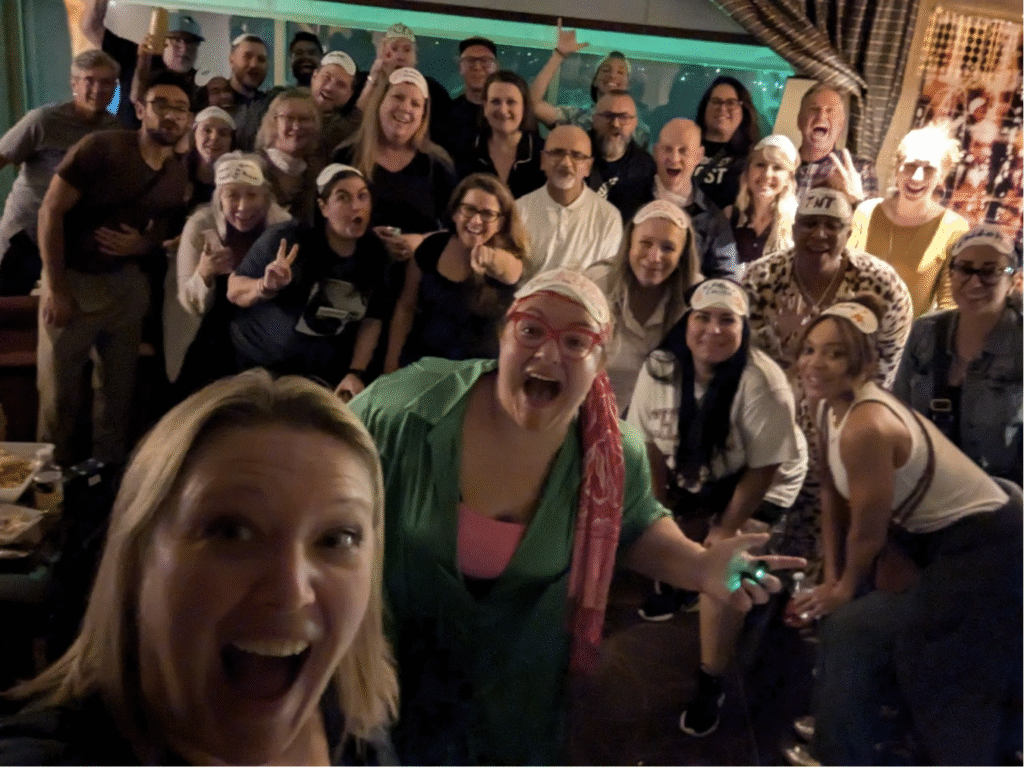
The Shift from Tentpoles to Micro-Events
Small events vs large events is more than a size comparison — it’s a shift in how organizations are planning their event portfolios. Rather than pouring all resources into one or two massive tentpoles, planners are embracing regional event strategies and the intimate events trend to create more targeted, cost-effective experiences. These smaller gatherings are proving that bigger isn’t always better when it comes to engagement, ROI, and lasting impact.
As Liz Lathan, founder of Club Ichi and a well-known voice in the event marketing world, notes in a recent conversation about the state of events, it’s not that budgets are shrinking — it’s that they’re being reallocated toward smaller, more targeted experiences.
Organizations are funneling resources into intimate, often bottom-of-the-funnel gatherings where meaningful conversations happen and business decisions are made. These aren’t “less than” versions of the old tentpoles; they’re smarter investments, designed to connect the right people in the right context.
Instead of betting everything on one flagship event, planners are curating portfolios of smaller, regional gatherings. These events may look modest on the surface, but they deliver deeper engagement and stronger outcomes. The shift reflects a larger truth: in-person connection doesn’t have to be big to be valuable — it just has to be meaningful.
Why Do Smaller Events Work Better?
Deeper Access and Connection
Smaller events create an experience that large conferences rarely deliver. Attendees consistently say they value access to subject-matter experts and authentic conversations over celebrity-style keynotes. That shift is showing up in the numbers too: 54% of planners report that most of their events now bring together 250 people or fewer, a format that naturally supports deeper learning and stronger networking.
Smarter Use of Resources
For organizations, these smaller gatherings are proving more sustainable and more strategic. Instead of pouring budget into one high-stakes tentpole, planners are building regional portfolios that spread out risk and maximize reach.
The Rise of “Destination Dupes”
Increasingly, planners are embracing what’s being called “destination dupes”: choosing less obvious, budget-friendly alternatives to the usual event hotspots. Just as leisure travelers might swap Paris for Montréal, event professionals are rethinking their defaults. Sacramento is emerging as a cost-effective alternative to San Francisco, while Fort Lauderdale offers Miami’s sunshine with less congestion and a lower price tag.
For planners, destination dupes make regional portfolios more achievable, allowing multiple touchpoints instead of one expensive flagship. For attendees, they provide accessible, comfortable environments where connection comes more naturally.
How Brands Can Build a Micro-Event Strategy
Adopting this approach requires a shift in planning. Rather than investing everything into one large conference, organizations are designing portfolios of smaller experiences that complement each other. A workshop in one city, a networking reception in another, and a micro-conference in a regional hub can add up to more touchpoints, more learning opportunities, and more chances to connect with audiences where they are.
Root the Experience in Local Culture
The strongest micro-events don’t feel copy-pasted from a corporate playbook. They draw from the character of the city or community they’re in. Partnering with local businesses, showcasing regional speakers, or weaving in cultural elements makes the event feel authentic and relevant.
Personalize at a Human Scale
Smaller gatherings give brands the chance to design experiences that feel made for the individual. Whether it’s tailoring topics to niche interests or giving attendees direct access to subject-matter experts, personalization is easier to deliver when you’re serving dozens or hundreds instead of thousands.
Use Interactivity to Turn Small Events Into Big Memories
The magic of micro-experiences lies in participation. When attendees are invited to do more than sit and listen, the event transforms into a space of collaboration and connection. Workshops, small group sessions, and live demos create environments where people walk away with new skills and stronger relationships, not just a notebook full of takeaways.
A perfect example comes from Liz Lathan at IMEX 2024. She organized a 2 AM pajama party to watch the Tropicana Hotel implode — a quirky, unforgettable idea that drew attendees to a conference room in their pajamas. The people who showed up didn’t just witness a Vegas spectacle; they bonded over the moment, creating relationships that still drive pipeline and partnerships today. More importantly, they connected as humans first, professionals second, and that memory has lasted far beyond the event itself.
That’s the power of interactivity in small events: it’s not the scale of the activity that matters, but the authenticity of the shared experience.

Hear more about this bold event strategy and others (including a session held on inflatable unicorns) in our recent webinar: Shaking Up Your Events Strategy – 5 Out-of-the-Box Ideas
Think in Terms of Journeys, Not Moments
A single event can spark excitement, but the real power comes from building a connected portfolio. When brands treat micro-experiences as part of an ongoing relationship — each one linked, measured, and refined — they create loyalty that lasts far beyond a single interaction.
Measuring Success With the Right Event Tech
Of course, smaller events don’t mean fewer expectations. Leaders still want to see impact. This is where the right event technology makes the difference.
From Headcount to Real Impact
Modern event tech goes beyond tracking who showed up. It captures the entire attendee journey, from registration through follow-up, surfacing insights like session attendance, engagement levels, and regional turnout. This allows planners to demonstrate outcomes that truly matter like pipeline influence, donor engagement, and student conversions directly tied back to each event. No more relying on vanity metrics like headcount alone.
Why Your CRM & Event Management Platform Relationship Matters
The real magic happens when event data flows directly into your CRM. Every registration, check-in, payment, and follow-up becomes part of a bigger picture, turning events from one-off activities into measurable drivers of applications, donations, renewals, and revenue.
ROI shows up in the same dashboards leadership already uses, eliminating spreadsheets and manual exports. In short, the right technology gives smaller events the credibility and transparency leaders need to keep investing in them.
The Future Belongs to Smaller, Smarter Events
The future of events won’t be defined by size but by connection. Smaller, smarter gatherings are winning because they create exactly what attendees and organizations are looking for: experiences that resonate, relationships that last, and outcomes that matter. And with the right event tech in place, planners can capture the proof points that show these events aren’t just engaging — they’re effective.
This is just one shift transforming the events landscape. Check out the full event planning trends report for data-driven insights, emerging strategies, and practical tips to measure how these changes are impacting your own events.
See how 350+ Salesforce teams run events
Feeling boxed in by your current event tools? Not quite ready for a one-on-one?
Watch our Essentials demo to see how teams are ditching disconnected tools and running every part of their events directly in Salesforce.


